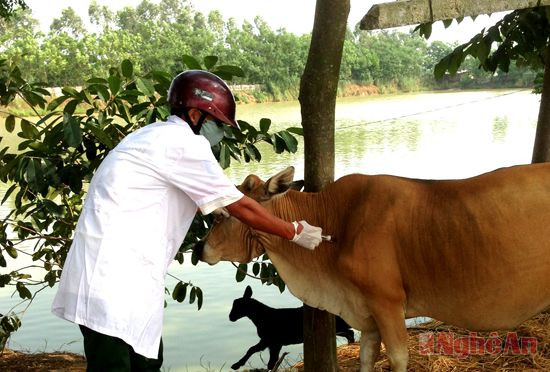Not paying attention to vaccinating livestock
(Baonghean) - According to information from the provincial Veterinary Department, since the beginning of the year, the disease situation in livestock and poultry has been basically stable. However, in the coming fall and winter, the risk of disease outbreaks in livestock is high, because the vaccination rate in localities is still low.
Nghe An has the largest livestock herd in the country. In recent years, the livestock herd has been stable and has shifted to regional distribution. The quality of buffalo, cow, and pig breeds has been improved, thereby increasing the total output and income from livestock farming. However, according to the assessment of the Department of Agriculture and Rural Development, in the first 6 months of 2015, the progress of vaccination and disinfection in livestock farming is still slow. Currently, the weather is hot, so there is a risk of dangerous epidemics such as avian influenza, blue ear in pigs, foot-and-mouth disease (FMD), heatstroke, etc.
Mr. Dang Van Minh, Deputy Head of the Provincial Veterinary Department, said that the vaccination rate for some vaccines in localities is still too low, especially the vaccination against swine septicemia only reached 30.7% of the plan, the vaccination against swine fever reached 37% of the plan, and the vaccination against rabies reached 32.9% of the plan. As for the vaccine against avian influenza, most livestock households have not proactively purchased it for vaccination. Some vaccines such as Blue Ear and FMD are expensive, and farmers have not yet paid for them, and are still waiting for support from the State.
 |
| Veterinary staff of Hung Nguyen district vaccinated cattle against anthrax. |
One of the biggest difficulties in the vaccination of livestock is that many local authorities lack attention and have not given strong direction in vaccination, and have left this task entirely to the veterinary sector. The mountainous commune of Nghia Hanh (Tan Ky) has a large livestock area, and along with afforestation, livestock is identified as a key economic sector of the locality, but the vaccination rate of the commune is very low. Specifically, in the spring of 2015, vaccination against anthrax in buffalo and cows reached 30%, the pig herd reached nearly 10%, and the poultry herd was mainly not vaccinated.
Mr. Vo Trong Phuong, Secretary of the Party Committee of Nghia Hanh Commune, shared: Although the Party Committee has directed the development of programs, plans, livestock projects and vaccination plans, the implementation process has not been resolute. For a long time, the commune has entrusted the hamlets and the Veterinary Department, and the high and low results of each hamlet and each household have not been specifically handled after each vaccination.
Tan Ky is a mountainous locality with a total herd of nearly 46,000 buffaloes and cows, over 47,000 pigs, and over 776,000 poultry. The entire district has 40 farms and mixed livestock farms that meet the prescribed standards. Many years ago, there were a number of FMD and blue ear outbreaks in the district, causing damage to livestock. From the beginning of 2015 until now, FMD outbreaks have also occurred in some livestock in Tan Lap hamlet, Dong Van commune. The reason is that people have not vaccinated their livestock.
Mr. Le Duc Tinh, Head of the Tan Ky District Veterinary Station, said: The entire district currently has 89/266 hamlets that enjoy the vaccination support regime, but this amount of vaccine only meets about 20 - 25% of the total herd (depending on each commune), the rest of the people have to buy it themselves. Due to the characteristics of free-range, small-scale livestock farming, many communes have not yet developed a vaccination mechanism, so the vaccination rate is still low. In the spring crop of 2015, vaccination against diseases on cattle and buffaloes only reached 60%, vaccination for pigs reached 10 - 15% of the total herd, and poultry seemed to not be vaccinated. This is also the common situation in many districts.
Mr. Dang Van Minh, Deputy Head of the Provincial Veterinary Department, added: Up to now, the amount of vaccines against septicemia in buffaloes, cows, and swine septicemia provided by the State to 11 mountainous districts only meets 30% of the number of livestock that need to be vaccinated. Most districts are facing difficulties in mobilizing people to invest in purchasing vaccines for livestock, especially in the plains districts.
An equally important issue in livestock vaccination is that localities have not yet implemented sanctions for violations or have not handled them strictly, leading to a low rate of livestock vaccination. Mr. Nguyen Huu Thong, Vice Chairman of the People's Committee of Hung Tan Commune (Hung Nguyen District) admitted: Decree 119/CP has stipulated the functions and authority of sectors from commune level and above to handle violations in livestock vaccination. However, it is very difficult to impose administrative sanctions on organizations and individuals who do not comply with livestock and poultry vaccination, leading to a low vaccination rate.
According to the recommendations of the provincial Veterinary Department, this year, the prolonged hot weather conditions have weakened the resistance of animals, increased pathogens in livestock and the environment, especially anthrax in buffalo, cows, pigs, and avian influenza outbreaks, which can easily lead to high mortality rates, especially in livestock that have not been fully vaccinated. The upcoming autumn vaccination season will take place in the rainy season, so the vaccination rate and targets are expected to be more difficult to achieve than in the spring season. To create efficiency in autumn vaccination for livestock, in the context of limited state budget, many localities need to proactively introduce appropriate policies and support funding for building a grassroots veterinary network. In addition, promote propaganda work, create consensus for people to implement vaccination for livestock, contributing to improving the efficiency of livestock farming, especially in mountainous districts. In particular, timely intervention by local government leaders in handling vaccination violations with decisive administrative measures is needed.
Luong Mai






